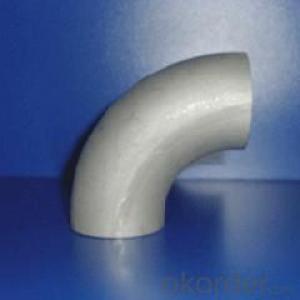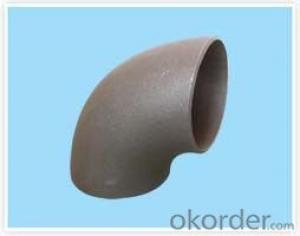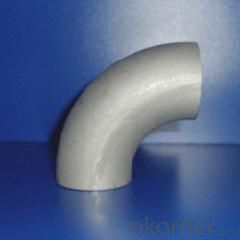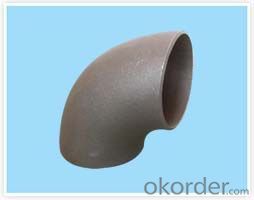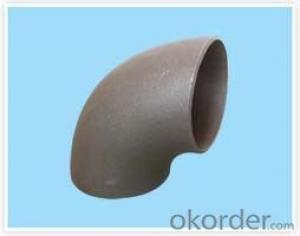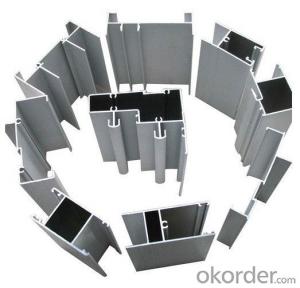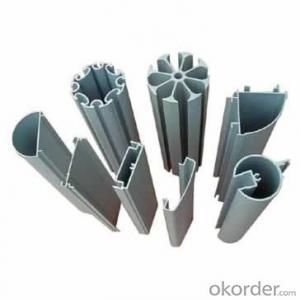T-Slot Aluminum Profiles 45 Degree Aluminum Elbow Profile
- Loading Port:
- China Main Port
- Payment Terms:
- TT OR LC
- Min Order Qty:
- -
- Supply Capability:
- -
OKorder Service Pledge
OKorder Financial Service
You Might Also Like
Specifications
45 degree aluminum elbow
1.size:1/2"-48"
2.standard:ASTM B16.9
3.Certification: ISO
Type | 45 degree elbow |
Size | 1/2"-48"DN15--DN1200 |
Wall Thickness | Sch5--Sch160XXS |
Standard | ISO, SNSI, JIS, DIN, GB/T12459GB/T13401ASME B16.9SH3408 SH3409HG/T21635HG/T21631SY/T05010 |
Material | 20#/Q235 |
Packaging | wooden cases or wooden pallet or as per customers requirement |
Applications Range | petroleum, chemical, power, gas, metallurgy, shipbuilding, construction, etc |
Min Order Quantity | According to customer's requirement |
Delivery Time | According to customer's requirement |
Quality | First grade |
Productivity | 8000000T/Y |
Others | 1.Special design available according to requirement 2.Anti-corrosion and high-temperature resistant with black painting 3. All the production process are made under the ISO9001:2008 strictly. |
- Q: How do I cut and shape aluminum profiles?
- In order to cut and shape aluminum profiles, one must possess several tools and techniques. Here is a step-by-step manual to aid you in accomplishing this task: 1. Obtain the required tools: A miter saw or a circular saw equipped with a carbide-tipped blade suitable for aluminum cutting is essential. Additionally, it is advisable to possess a metal file, sandpaper, a deburring tool, and a tape measure. 2. Measure and mark: Utilize a tape measure to determine the desired length of the aluminum profile. Indicate the location where the cut is to be made using a pencil or marker. 3. Secure the aluminum: Firmly place the aluminum profile on a workbench or cutting surface. Utilize clamps or a vice to hold it securely in place, ensuring it remains stationary during the cutting process. 4. Cut the aluminum: Position the saw blade at the marked location and align it perpendicular to the aluminum profile. Initiate the saw and gradually guide it through the aluminum, applying constant pressure. Allow the saw to perform the task without exerting excessive force, as excessive pressure may cause the blade to bind or chip. Exercise caution and wear safety goggles and gloves to shield yourself from any flying debris. 5. Smooth the edges: Following the cut, you may observe sharp or rough edges on the aluminum profile. Employ a metal file or sandpaper to level these edges, ensuring a clean and safe outcome. 6. Deburring: Employ a deburring tool to eliminate any burrs or rough spots remaining from the cutting process. Gently run the tool along the cut edges, applying slight pressure to smoothen them. 7. Shape the aluminum: If shaping the aluminum profile is necessary, numerous methods can be employed. A common technique involves clamping the profile to a workbench and gradually bending it using a hammer or rubber mallet. Alternatively, specialized tools such as a metal brake or bending machine can be utilized for more precise shaping. 8. Final touches: Once the aluminum profile has been cut and shaped, thoroughly clean it to eliminate any debris or metal shavings. Inspect the profile for any imperfections and make necessary adjustments before employing it for the intended application. Remember to exercise proper safety precautions throughout the process, including wearing safety goggles, gloves, and securely fastening the aluminum profile to prevent accidents.
- Q: How do aluminum profiles provide structural stability?
- Aluminum profiles provide structural stability through their inherent properties and design characteristics. Firstly, aluminum is a lightweight yet strong material, making it ideal for constructing various structures. Its high strength-to-weight ratio means that it can support heavy loads while minimizing the overall weight of the structure. Additionally, aluminum profiles can be designed with various shapes and cross-sections, allowing for optimal load distribution and structural integrity. These profiles can be extruded into different shapes, such as I-beams, T-sections, or rectangular profiles, which can provide enhanced strength and rigidity to the structure. Moreover, aluminum has excellent corrosion resistance, which ensures that the profiles remain durable and structurally sound even in harsh environments. This resistance to corrosion eliminates the need for frequent maintenance and extends the lifespan of the structure. Furthermore, aluminum profiles can be easily fabricated and assembled, allowing for efficient and cost-effective construction. They can be cut, drilled, welded, or fastened together to create complex structures with precise dimensions. This flexibility in fabrication and assembly ensures that the profiles can be tailored to meet specific design requirements and provide optimal structural stability. In conclusion, aluminum profiles provide structural stability through their lightweight yet strong nature, versatile design options, corrosion resistance, and ease of fabrication and assembly. These properties make aluminum profiles a preferred choice in various industries, including construction, transportation, aerospace, and many others.
- Q: Are aluminum profiles suitable for fencing and gates?
- Indeed, fencing and gates can be effectively constructed using aluminum profiles. This material is widely favored in such applications due to its exceptional durability, strength, and minimal maintenance requirements. Its resistance to rust, corrosion, and weathering also renders it an outstanding choice for outdoor utilization. Moreover, aluminum profiles afford flexibility in terms of design, enabling the incorporation of various styles and customizable options. Despite their lightweight nature, these profiles maintain robustness, thus facilitating effortless installation and handling. Furthermore, the sustainability and eco-friendliness of aluminum cannot be overlooked, as it is entirely recyclable. In summary, aluminum profiles present a pragmatic and visually appealing solution for fencing and gates.
- Q: Is it possible to utilize aluminum profiles as a material for flooring?
- <p>Yes, aluminum profiles can be used for flooring, particularly in industrial or commercial settings where durability and resistance to wear are required. They are known for their strength, lightweight, and corrosion resistance, making them suitable for high-traffic areas. Aluminum profiles can be used to create grid systems or as support structures for modular flooring solutions. However, they are not typically used as the direct surface material for flooring due to their hardness and potential for thermal conductivity, which can make them uncomfortable underfoot. Instead, they are often part of a system that supports other flooring materials like tiles or planks.</p>
- Q: How do you cut aluminum profiles?
- If you need to cut aluminum profiles, there are a variety of methods available to you depending on the tools and equipment at your disposal. Here, we will discuss three commonly utilized techniques: 1. Power Saw: To effectively cut aluminum profiles, a power saw like a miter saw or circular saw equipped with a specialized carbide-tipped blade designed for metal cutting is recommended. Adjust the blade to the appropriate speed and angle for your desired cut, and carefully guide the saw through the profile, ensuring a smooth and precise cut. 2. Hacksaw: If power tools are not accessible, a hacksaw is a cost-effective and readily available alternative. Select a fine-toothed blade designed for cutting metal and securely fix the aluminum profile in a vise or workbench. Employ long, steady strokes to slice through the profile, applying gentle pressure to maintain control and prevent blade binding. 3. Shearing: For thinner aluminum profiles, a manual shear can be employed to make straight cuts. Position the profile in the shear, aligning the cutting edge with the desired cut line, and steadily exert pressure on the handle to allow the shear to effortlessly slice through the aluminum. This method is particularly suitable for cutting thinner profiles with precision and minimal risk of distortion. Regardless of the method you choose, it is crucial to wear appropriate safety gear, such as safety glasses and gloves, to safeguard yourself against metal shavings and sharp edges. Moreover, always accurately measure and mark your cut line before initiating the cutting process to ensure your desired outcome.
- Q: Can aluminum profiles be used for rooftop installations?
- Yes, aluminum profiles can be used for rooftop installations. Aluminum is a lightweight and durable material that is commonly used in construction and engineering projects. It has excellent strength-to-weight ratio and is resistant to corrosion, making it suitable for outdoor applications, including rooftop installations. Aluminum profiles can be specifically designed and engineered to meet the specific requirements of rooftop installations. These profiles can be used for various purposes, such as supporting solar panels, creating rooftop walkways or platforms, or constructing guardrails and handrails. One of the main advantages of using aluminum profiles for rooftop installations is their corrosion resistance. Aluminum naturally forms a protective oxide layer, which helps to prevent rust and corrosion, even in harsh weather conditions. This makes aluminum profiles a long-lasting and low-maintenance option for rooftop installations. Furthermore, aluminum profiles can be easily fabricated and customized to fit specific rooftop dimensions and designs. They can be cut, welded, and formed into various shapes and sizes to meet specific installation requirements. This versatility allows for easy installation and ensures a precise fit, resulting in a secure and stable rooftop structure. Lastly, aluminum is a sustainable and environmentally friendly material. It is 100% recyclable, meaning it can be reused or repurposed at the end of its lifespan. This reduces waste and contributes to a greener and more sustainable construction industry. In conclusion, aluminum profiles are an excellent choice for rooftop installations. Their lightweight, corrosion resistance, versatility, and sustainability make them a reliable and practical option for various rooftop applications.
- Q: How are the aluminum and aluminum sections joined?
- The frame structure is connected with special connecting pieces according to different specifications, and your graphic 40*40 can only be connected through an outer connecting piece. You can go to the profile dealer to purchase the relevant accessories.
- Q: This question asks about the various types of fastening mechanisms used to attach exterior walls to the structural frames of buildings.
- <p>Different types of fasteners used to secure exterior walls to building frames include nails, screws, bolts, and anchors. Nails are commonly used for wood-framed structures, while screws offer greater holding power. Bolts are used in steel or concrete structures and can be either through-bolts or expansion bolts. Anchors, such as masonry or concrete anchors, are used for securing to masonry or concrete walls. Additionally, adhesives and mechanical fasteners like clips and brackets are also used depending on the material and design of the exterior wall and building frame.</p>
- Q: What are the different types of anodizing options for aluminum profiles?
- There are several types of anodizing options for aluminum profiles, including sulfuric acid anodizing (SAA), chromic acid anodizing (CAA), hard anodizing, and two-step anodizing. SAA is the most common type, providing a durable and corrosion-resistant finish. CAA offers a thinner and less durable coating, but it is commonly used for aerospace applications. Hard anodizing produces a thicker and harder coating, ideal for high-wear applications. Two-step anodizing involves an additional coloring process, allowing for a wide range of decorative finishes.
- Q: Can aluminum profiles be used for creating display systems?
- Yes, aluminum profiles can be used for creating display systems. Aluminum is a versatile and lightweight material that is widely used in various industries, including the display and signage industry. Aluminum profiles offer several advantages for creating display systems. Firstly, aluminum is highly durable and corrosion-resistant, making it suitable for both indoor and outdoor display applications. It can withstand various environmental conditions, ensuring the longevity of the display system. Secondly, aluminum profiles are easily customizable. They can be extruded into various shapes and sizes, allowing for flexibility in design. This makes it possible to create unique and eye-catching display systems that meet specific requirements. Additionally, aluminum profiles are easy to assemble and disassemble, which is beneficial for display systems that require frequent changes or transportability. They often come with a simple slot and groove system or other connecting mechanisms, making installation and maintenance hassle-free. Moreover, aluminum profiles can be anodized or powder-coated to provide a decorative or protective finish. This allows for customization in terms of color and texture, enhancing the aesthetics of the display system. Lastly, aluminum profiles provide structural stability while remaining lightweight. This makes them suitable for large-scale displays or installations where weight is a concern. In summary, aluminum profiles are an excellent choice for creating display systems due to their durability, customizability, ease of assembly, and aesthetic appeal.
Send your message to us
T-Slot Aluminum Profiles 45 Degree Aluminum Elbow Profile
- Loading Port:
- China Main Port
- Payment Terms:
- TT OR LC
- Min Order Qty:
- -
- Supply Capability:
- -
OKorder Service Pledge
OKorder Financial Service
Similar products
Hot products
Hot Searches
Related keywords
